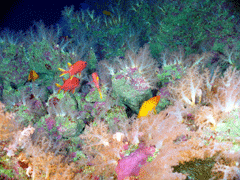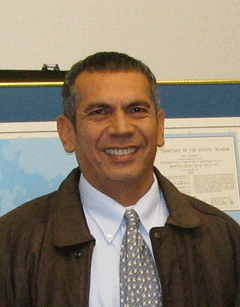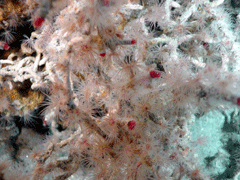Marianas National Marine Monument
Air Date: Week of December 5, 2008

Soft corals and tropical fish on the summit of an underwater volcano in the Mariana Islands. (Courtesy of the NOAA Submarine Ring of Fire 2004 Exploration and the NOAA Vents Program)
With a little more than a month left in office, President Bush still has a chance to leave a blue-green legacy. That’s if he declares 150,000 square miles of the Pacific Ocean a marine monument. Andrew Salas, vice chair of Friends of the Monument, tells host Bruce Gellerman that the area, which includes his homeland in the Northern Mariana Islands, has a wide and beautiful diversity of marine life that deserves protection.
Transcript
GELLERMAN: With just a few weeks left to his term as president, George W. Bush is seeking to burnish a blue-green legacy.
Two years ago, Mr. Bush put 140,000 square miles of Pacific Ocean, north of Hawaii, off limits to oil drilling and fishing. Now, the President hopes to protect another vast area of the ocean – this one 4,000 miles west of Hawaii. It includes three of the remote Northern Mariana Islands and the Mariana Trench, the deepest spot in the ocean – a gash in the earth’s crust nearly seven miles down. The proposal has some influential supporters - including first lady Laura Bush - and prominent opponents. Among those trying to sink the President’s plan to create this National Marine Monument is Vice President Dick Cheney, and nearly all of the elected officials of Micronesia.
But many residents want to win federal protection, including Andrew Salas, vice president of the organization Friends of the Monument. Mr. Salas, welcome!
SALAS: Thank you.
GELLERMAN: Which three islands are we talking about?
SALAS: Maug, Asuncion, and Uracus. The water surrounding those three islands.
GELLERMAN: So how many square miles we talking here?
SALAS: About 115,000.

Mr. Andrew Salas, vice president of Friends of the Monument and former congressman of the Commonwealth of the Northern Marianas Islands.
GELLERMAN: I gotta tell you, the one that was named two years ago is 140,000.
SALAS: That’s the reason why we came to D.C. This is my first trip to D.C., and I want to ask the good president to please make it bigger than the Islands in Hawaii.
GELLERMAN: So how much bigger?
SALAS: Maybe an inch bigger. [LAUGHS]
GELLERMAN: So those are kinda bragging rights?
SALAS: Yes sir. Nobody ever remembers second place in the World Series or the second place at the Super Bowl. Always remember the champ.
GELLERMAN: Well how would that help the people of Northern Marianas?
SALAS: Well you know, you know, have you ever been to the Northern Marianas islands?
GELLERMAN: No, I haven’t.

A close-up of the tubeworm found at two volcanoes in the Northern Mariana Islands. (Courtesy of the NOAA Submarine Ring of Fire 2004 Exploration and the NOAA Vents Program)
GELLERMAN: Mr. Salas, what would protection under this marine reserve do for the area?
SALAS: Well, for one, you know, those three islands are – they’re about 300 miles from Saipan. Right now we don’t have the means – it is protected by constitution, but we do not have the means to patrol that area and protect it. As a matter of fact, maybe seven or eight weeks ago, we caught a Taiwanese ship poaching in our waters. So, at the most basic, fundamental protection is at least to keep outsiders away from our islands and to stop poaching our fish in our waters. Look at what’s happening with the fish stocks all over the world. This will provide an area where fish can be protected and when they get big they can lay an abundance of eggs and they can go out, outside the protected areas and everybody can benefit from it.
GELLERMAN: Strange – I mean here you’ve got Laura Bush and the President supporting this and they’re being opposed by the Vice President Cheney.

Soft corals and tropical fish on the summit of an underwater volcano in the Mariana Islands. (Courtesy of the NOAA Submarine Ring of Fire 2004 Exploration and the NOAA Vents Program)
SALAS: [Laugh] Well, it’s not a perfect world, but we try our best, you know. The governor of the commonwealth thinks of this as another federal intrusion and it’s not. In our possession today we have original copies of over 6,000 signatures from our people from our beautiful commonwealth that sign in support of this monument.
GELLERMAN: Mr. Salas, what was this place like when you were young?
SALAS: Ah, it was beautiful. And that’s why we – you know, Beach Road is our main road, our primary road when I was growing up. And when the fish would come into the lagoon, our blue water became really dark. And every islander that was passing by, whether driving, bicycling or walking, all they had to do was come up to the beach and they get a coffee can full of whatever fish was in the lagoon. But now you gotta go miles to fish. And we’re hoping that President Bush takes the time to make a bold move to declare it a marine monument so that the people of the commonwealth can have a place where young people can remember, like I remember, thirty years ago, forty years ago, about the beauty of our lagoon on Beach Road.
GELLERMAN: Well Mr. Salas, I want to thank you very much.
SALAS: Thank you sir. It was my pleasure.
GELLERMAN: Andrew Salas is vice president of Friends of the Monument – a group seeking protection for the Northern Mariana Islands.
Links
Living on Earth wants to hear from you!
Living on Earth
62 Calef Highway, Suite 212
Lee, NH 03861
Telephone: 617-287-4121
E-mail: comments@loe.org
Newsletter [Click here]
Donate to Living on Earth!
Living on Earth is an independent media program and relies entirely on contributions from listeners and institutions supporting public service. Please donate now to preserve an independent environmental voice.
NewsletterLiving on Earth offers a weekly delivery of the show's rundown to your mailbox. Sign up for our newsletter today!
 Sailors For The Sea: Be the change you want to sea.
Sailors For The Sea: Be the change you want to sea.
 The Grantham Foundation for the Protection of the Environment: Committed to protecting and improving the health of the global environment.
The Grantham Foundation for the Protection of the Environment: Committed to protecting and improving the health of the global environment.
 Contribute to Living on Earth and receive, as our gift to you, an archival print of one of Mark Seth Lender's extraordinary wildlife photographs. Follow the link to see Mark's current collection of photographs.
Contribute to Living on Earth and receive, as our gift to you, an archival print of one of Mark Seth Lender's extraordinary wildlife photographs. Follow the link to see Mark's current collection of photographs.
 Buy a signed copy of Mark Seth Lender's book Smeagull the Seagull & support Living on Earth
Buy a signed copy of Mark Seth Lender's book Smeagull the Seagull & support Living on Earth

